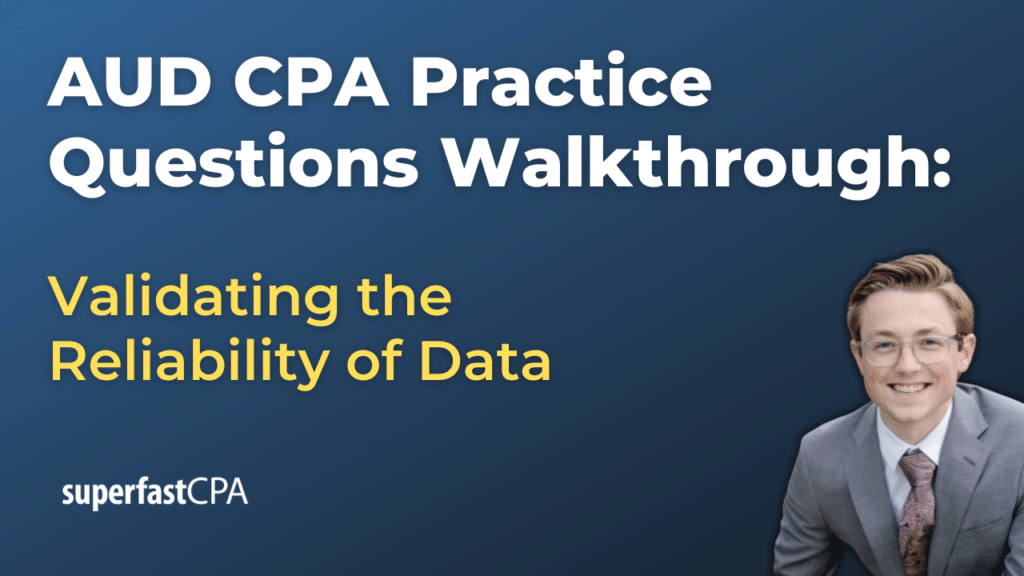In this video, we walk through 5 AUD practice questions teaching about validating the reliability of data. These questions are from AUD content area 3 on the AICPA CPA exam blueprints: Performing Further Procedures and Obtaining Evidence
The best way to use this video is to pause each time we get to a new question in the video, and then make your own attempt at the question before watching us go through it.
Also be sure to watch one of our free webinars on the 6 “key ingredients” to an extremely effective & efficient CPA study process here…
Validating the Reliability of Data
Reliable data is the foundation of a quality audit. Auditors must evaluate the completeness, accuracy, authenticity, and susceptibility to management bias of the information they rely on. This means verifying that data is not only correct but also free from omissions or distortions that could affect financial reporting.
To do this, auditors perform procedures such as reconciling data to original sources, validating search criteria, and analyzing financial totals. These steps help ensure that audit conclusions are based on trustworthy information.
External Evidence Provides Greater Reliability Than Internal Reports
Independent, third-party evidence carries more weight than information generated within the company. Auditors prioritize external confirmations, bank statements, and supplier invoices over internal spreadsheets or management-prepared schedules.
Example:
A company reports high sales revenue, supported by an internal sales report. Instead of relying solely on this document, the auditor traces recorded sales to actual bank deposits and third-party payment processor records, ensuring the revenue is both accurate and complete.
Audit Data Analytics Must Be Performed on Reliable Data
Audit data analytics (ADA) allows auditors to analyze large datasets and identify trends, but these analytics are only useful if the data itself is reliable. Auditors must confirm data accuracy before running any analyses.
Example:
An auditor wants to analyze refund trends for possible fraud. Before doing so, they confirm that all refund transactions are included by reconciling the refund database to the general ledger. This prevents incomplete data from distorting the results.
Analyzing Financial Totals Helps Detect Errors and Fraud
Reviewing account balances and financial totals can uncover inconsistencies, but auditors must go beyond surface-level analysis. If totals appear unusual, further verification is needed.
Example:
A company’s inventory balance shows a sharp increase at year-end. The auditor:
- Checks inventory counts against supplier invoices and warehouse records.
- Reviews revenue recognition policies to ensure inventory isn’t being inflated to manipulate earnings.
- Performs a physical inventory count to verify existence.
Evaluating Authenticity and Management Bias
Management bias can impact financial reporting, whether through intentional misstatements or optimistic assumptions. Auditors assess whether transactions are real and whether management has incentives to misrepresent financial data.
Example:
A software company reports a large deferred revenue balance. The auditor investigates whether these transactions are legitimate by:
- Reviewing customer contracts to confirm payments were received before recognizing revenue.
- Contacting customers to verify that prepayments actually occurred.
- Analyzing manual journal entries to check for last-minute adjustments that could artificially boost revenue.
Choosing the Right Reliability Procedures for the Audit Objective
Different situations require different verification methods. Auditors select procedures based on the nature of the data and the risks involved. Some common approaches include:
- Confirmations: Verifying balances with banks, customers, or suppliers.
- Reconciliations: Comparing internal records to external statements or documents.
- Cutoff Testing: Ensuring transactions are recorded in the correct period.
- Trend Analysis: Identifying unexpected shifts in financial data that may indicate misstatements.
Conclusion
Auditors must assess the reliability of financial data before drawing conclusions. External confirmations, reconciliations, audit data analytics, and financial total analysis all play a role in validating completeness, accuracy, and authenticity. By applying the right procedures, auditors can ensure they are working with data they can trust.














